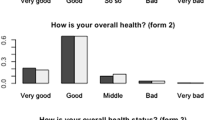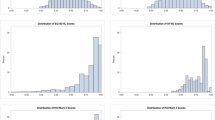Abstract
This study presents information on the test-retest reliability of the Health Utility Index—Mark III (HUI) system used in cycle 6 of the Canadian General Social Survey (GSS). The HUI system used in this reliability study consists of an eight-attribute health status classification system (HSCS) and a function for generating a summary score of health-related quality of life. To estimate test-retest reliability, a stratified random sample of individuals (n=506) completing GSS telephone interviews during August and September, 1991 were interviewed again 1 month later. Weighting adjustments based on the probability of selection were invoked during the analyses to provide unbiased estimates of testretest reliability for all GSS respondents in the August-September period. The results indicate that the individual questions, attributes and provisional index scores generally provided reliable information on health status in the GSS. The exceptions to this were limitations in speech and dexterity which were reported very infrequently. Kappa estimates of test-retest reliability for individual questions varied from 0.184 to 0.766. For the eight attributes, kappa estimates varied from 0.137 to 0.728. Using the provisional index scores to quantify health overall, a test-retest reliability of 0.767 was obtained (intra-class correlation coefficient).
Similar content being viewed by others
References
Guyatt GH, Feeny DH, Patrick DL. Measuring health-related quality of life.Ann Intern Med 1993;118: 622–629.
Patrick DL, Deyo RA. Generic and disease-specific measures in assessing health status and quality of life.Med Care 1989;27 (Suppl.) S217-S232.
Torrance GW, Boyle MH, Horwood SP. Application of multi-attribute utility theory to measure social preferences for health states.Oper Res 1982;30: 1043–1069.
Feeny D, Furlong W, Barr RD, Torrance GW, Rosenbaum P, Weitzman S. A comprehensive multi-attribute system for classifying the health status of survivors of childhood cancer.J Clin Oncol 1992;10: 923–928.
Torrance GW, Furlong W, Feeny D, Boyle MH.Provisional Health Status Index for the Ontario Health Survey. Final Report Submitted to Statistics Canada. (Contract 44400900187) Hamilton, Ontario: Centre for Health Economics and Policy Analysis, McMaster University, 1992.
Drummond MF, Stoddart GL, Torrance GW.Methods for the economic evaluation of health care programmes. Oxford: Oxford University Press, 1987.
Feeny D, Torrance GW, Goldsmith CH, Furlong W, Boyle M. A multi-attribute approach to population health status. In:1993 Proceedings of the Social Statistics Section of the American Statistical Association. Alexandria, Virginia: American Statistical Assoociation, 1994: 161–166.
Feeny D, Furlong W, Boyle M, Torrance GW. Multiattribute health status classification systems: health utilities index.Pharmacoeconomics (in press).
Torrance GW, Furlong W, Feeny D, Boyle M. Multiattribute preference functions: health utilities index.Pharmacoeconomics (in press).
Catlin G, Will P. The National Population Health Survey: highlights of initial developments.Health Reports 1992; (Statistics Canada Cat. 82-003)4: 313–319.
Government of Canada.National Longitudinal Survey of Children: Overview of Survey Instruments 1994. (Cat. No. 94-02) Ottawa, Ontario: Author.
Ontario Ministry of Health.Ontario Health Survey 1990: User's Guide Vol 1 Documentation. Toronto, Ontario: Premiers Council on Health, Well-Being and Social Justice, 1992.
Statistics Canada.General Social Health Survey (99); Public Use Microdata File Documentation and User's Guide. Ottawa, Ontario: Ministry of Industry, Science and Technology, 1992.
Torrance GW, Zhang Y, Feeny D, Furlong W, Barr R.Multi-attribute Preference Functions for a Comprehensive Health Status Classification System (Working Paper 92-18). Hamilton, Ontario: Centre for Health Economics and Policy Analysis, McMaster University, 1992.
Cohen J. A coefficient of agreement for nominal scales.Educ Psychol Measurement 1960;20: 37–46.
Cohen J. Weighted kappa: nominal scale agreement with provision for scaled disagreement or partial credit.Psychol Bull 1968;70: 213–22.
Bartko JJ. On various intraclass correlation reliability coefficients.Psychol Bull 1976;83: 762–765.
Landis JR, Koch GG. The measurement of observer agreement for categorical agreement.Biometrics 1977;33: 159–174.
Shrout PE, Spitzer RL, Fleiss JL. Quantification in agreement in psychiatric diagnosis revisited.Arch Gen Psychiatry 1987;44: 172–177.
Hays RD, Anderson R, Revicki D. Psychometric considerations in evaluating health-related quality of life measures.Qual Life Res 1993;2: 441–449.
McDowell I, Newell C.Measuring health: a guide to rating scales and questionnaires. New York: Oxford University Press, 1987.
Author information
Authors and Affiliations
Additional information
This work was supported by Statistics Canada (Contract 84500900536). Dr Boyle is supported by a William T. Grant Faculty Scholar Award.
Rights and permissions
About this article
Cite this article
Boyle, M.H., Furlong, W., Feeny, D. et al. Reliability of the Health Utilities Index—Mark III used in the 1991 cycle 6 Canadian General Social Survey Health Questionnaire. Qual Life Res 4, 249–257 (1995). https://doi.org/10.1007/BF02260864
Received:
Accepted:
Issue Date:
DOI: https://doi.org/10.1007/BF02260864




